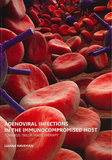Adenoviral infections in the Immunocompromised Host
Towards tailor-made therapy

Haveman, Lianne
- Promoter:
- Prof.dr A.B.J. (Berent) Prakken & prof.dr W. (Wietse) Kuis
- Co-promoter:
- Dr M.B. (Marc) Bierings
- Research group:
- Prakken
- Date:
- March 30, 2010
- Time:
- 16:15 h
Summary
Adenoviruses (HAdV) can cause serious life threatening infections, especially in pediatric patients after allogeneic stem cell transplantation (SCT). To improve the morbidity and mortality rate of HAdV infected patients after SCT three issues have been explored: which patients are at risk for HAdV infection, what is the best treatment for HAdV infected patients and when do we start treatment. We found that in pediatric patients HAdV-DNA positivity in nasopharyngeal aspirate before SCT is a very important risk factor for developing invasive HAdV infection after SCT. As determined with multiplex immuno-assay we also found that children with a localized HAdV infection have a different cytokine profile compared with patients with an invasive HAdV infection after SCT. Cytokine signatures can also be helpful to differentiate invasive HAdV infection from other SCT related complications as Graft versus Host Disease (GvHD) and Epstein-barr virus infection. Immune profiling could possibly help to identify patients at high risk in an earlier stage. Because no effective medication for HAdV infection exists and HAdV-specific T-cells are critically involved in virus elimination, an alternative treatment option is the adoptive transfer of HAdV-specific T-cells from the graft donor into the recipient. One of the potential risks of using HAdV-specific T-cells for adoptive therapy is the risk for GvHD. The use of a high purity of HAdV-specific CD4+ T-cells would strongly reduce this risk. By using a computer algorithm designed to predict pan HLA-DR binding T-cell epitopes we detected six 15-mer epitopes from HAdV. These epitopes induce a proliferative T-cell response in the majority of healthy controls. By culturing peripheral blood mononuclear cells (PBMCs) of healthy donors with identified HAdV epitopes it is possible to generate CD4+ HAdV-specific T-cells. With artificial antigen presenting cells, composed of liposomes harboring a HAdV-peptide and MHC-class II complex, these HAdV-specific T-cells could be isolated. Isolated HAdV CD4+ specific T-cells are fully functional, produce pro-inflammatory cytokines, express the cytotoxins perforin and granzyme B, kill HAdV-infected cells effectively and do not show alloreactivity. Because umbilical cord blood transplants (UCB) emerge as an alternative stem cell source for SCT, and immune reconstitution is delayed in patients receiving UCB, higher infection rates with HAdV are expected to emerge. In case of HAdV infection after UCB transplantation adoptive therapy with HAdV-specific T-cells derived from cord blood seems also a promising treatment option. However, the induction of HAdV-specific T-cells from UCB requires the priming and expansion of naive T-cells rather than expansion of pre-existing virus-specific memory T-cells. By stimulating cord blood mononuclear cells with 15-mer peptides we showed that HAdV-specific T-cells could be generated. The HAdV-specific T-cells produce pro-inflammatory cytokines, perforin and granzyme B, all necessary for viral elimination. The generation of HAdV-specific T-cells in response to HAdV peptides seems an essential step in developing tailor-made therapy for HAdV infection for recipients of SCT transplants. In the near future probably high-risk patients may be treated prophylactically with adoptive transfer of HAdV-specific T-cells, possibly in association with antiviral medication. These new approaches hopefully will lead to reduction in incidence and mortality rate associated with HAdV infection after SCT.